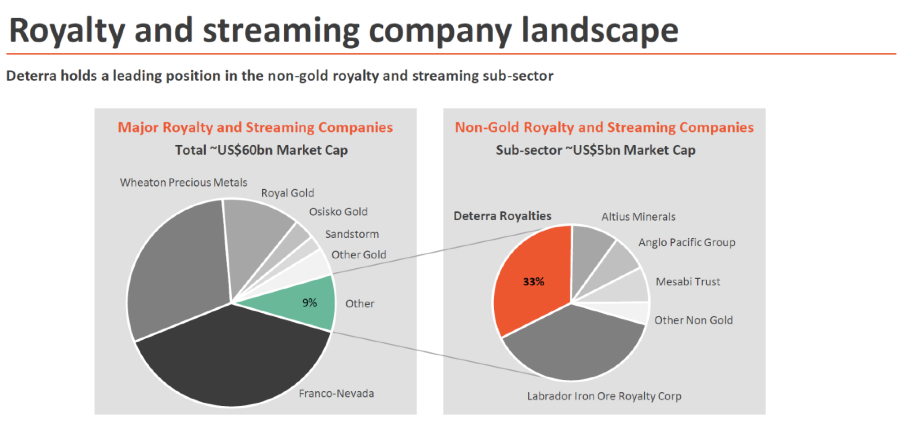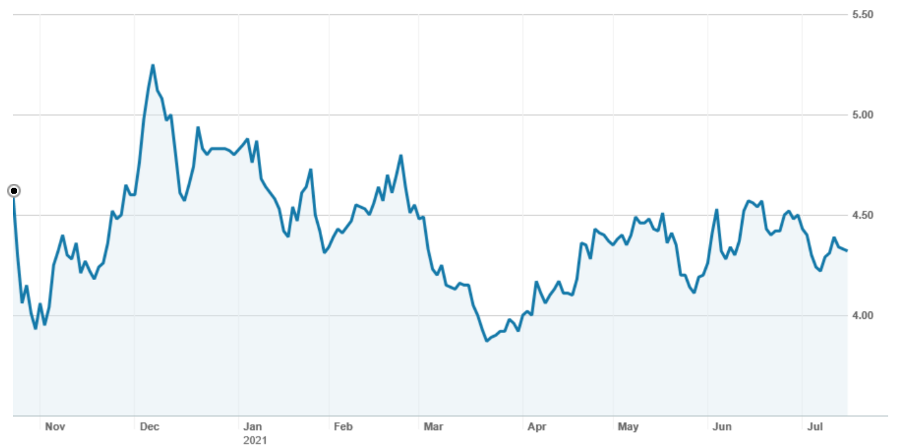Investing in a royalty company isn’t one of the most glamorous investment ideas, but it is an interesting proposition for income seekers, particularly when the yield on offer is 5% fully franked. But like any investment, royalty investments carry risk.
Globally, listed royalty and streaming companies have a market capitalisation in excess of US$60 billion. Most earn their royalty from the production of gold and other precious minerals, with the largest being Toronto and NYSE listed Wheaton Precious Metals and Franco-Nevada. Typically, the own the mining rights, or provide the capital, to a producing company and in return earn part of the sales revenue.

The non-gold royalty and streaming market has a market cap of around U$5bn. Deterra Royalties (ASX: DRR) is the second largest and the major royalty company listed on the ASX. There are other royalty companies on the ASX, including High Peak Royalties (HPR), Emmerson Resources (ERM), Gullewa (GUL) and Fitzroy River Corporation (FZR), but as my colleague James Dunn concluded a couple of months’ back, “for quality and reliability, it’s Deterra and then daylight.”
Deterra was spun out of Iluka Resources (ILU) through a demerger in early November. Iluka maintained a 20% holding, with the balance of shares being dispersed on a 1:1 basis to existing Iluka shareholders.
Deterra’s major royalty asset is ‘Mining Area C’ or MAC, an iron ore producing area in the Pilbara in Western Australia. MAC is home to the North Flank and BHP’s South Flank mines, and will become the largest operating iron ore hub in the world with a capacity to produce up to 145 Mtpa (million tonnes per annum).

This forecast 2.4 times expansion in production is one of the things that makes MAC so interesting to a royalty company. It gets paid a royalty of 1.232% of MAC product revenue, plus $1m per one million tonne increase in annual production above 57M tonnes. And because the miners (BHP, Itochu and Mitsui) are producing iron ore at a cost which puts them in the bottom quartile globally, the risk of reduced production is low.
The company’s other royalty is from a mineral sands site in SW Western Australia mined by Doral Mineral Sands. It also has three other projects in exploration/development.
For the first nine months of FY21, the company earnt $85.4m in royalties. The March quarter of $36.4m was up 48% on the December quarter.
In terms of growth, the company has a targeted strategy focussing on “value accretive investment”. It is seeking to create new royalties by providing project capital and balance sheet repair to bulk, base and battery metal miners at or nearing production (target $100m to $300m), and to acquire existing royalties.

The company says that it plans to maintain a strong balance sheet and will be disciplined in allocating capital. It has access to significant debt capacity, and plans to pay franked dividends that are 100% of NPAT.
The interesting thing about Deterra is that its share price has languished. After the demerger, it hit $5.35 in early December, but despite the iron ore price rising by almost 40% since then and BHP announcing in May its first production at the South Flank mine, Deterra shares closed on Friday at $4.40.
Deterra Royalties (DRR)

What do the brokers say?
The brokers are positive on the stock, with 4 buy recommendations and 1 neutral recommendation. According to FNArena, the consensus target price is $4.95, 12.5% higher than Friday’s closing price of $4.340. The range is from a low of $4.50 from Citi through to a high of $5.50 from Macquarie.
This precis of a recent research report from Morgan Stanley is a good summary:
Morgan Stanley assesses Deterra Royalties offers a unique investment. Growth is dominated by the planned expansion for the MAC iron ore royalty yet the broker envisages potential to acquire Australian royalties held by overseas companies.
Morgan Stanley expects benchmark iron ore prices will soften to around US$68/t by 2023 because of supply improvements and emissions-related production constraints in China.
Yet Deterra’s yield is much less sensitive to moves in the iron ore price compared with iron ore producers because of a lack of production costs.
While a lack of comparables makes the stock hard to value, the broker finds Deterra Royalties has the most upside of its iron ore exposed names and initiates coverage with an Overweight rating and $4.80 target. Industry view is Attractive.
For income seekers, the brokers forecast total dividends for FY21 (the period covers less than eight months and the payout is impacted by some up-front costs) of 11.7c per share. For FY22, this is expected to rise to 22.3c per share. This puts Deterra on a forecast yield of 2.7% for FY21, rising to 5.1% for FY22. Dividends will be fully franked.
There is considerable variability in the FY22 dividend forecast – a low of 14c per share to as high as 29 cents per share.
What are the risks?
Witt 99% of Deterra’s revenue coming from MAC, its number one risk is the iron ore price. And that’s the Australian dollar equivalent price. It not involved in production, so it doesn’t have any production or mining risks, however it is exposed to the output the miners produce. In this regard, it is reasonably well positioned because the mining area is a world class, low cost operation.
Deterra itself is a lean company, with outsourced corporate functions and very modest working capital facility. Its policy is to pay 100% of NPAT to shareholders.
Bottom line
I like the look of Deterra at the “right price”. I think the expansion of South Flank and production capacity builds in some safety in regard to the risk of a plummeting iron ore price. And the prospect of a 5% fully franked yield is attractive.
Buy up to $4.70.
Important: This content has been prepared without taking account of the objectives, financial situation or needs of any particular individual. It does not constitute formal advice. Consider the appropriateness of the information in regard to your circumstances.

